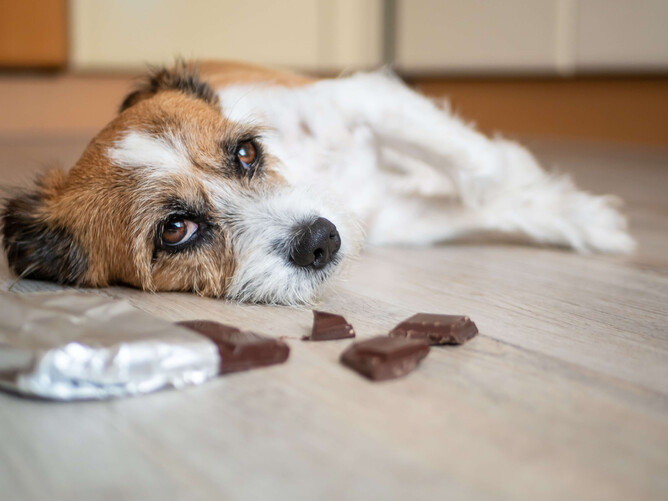Chocolate is delicious - to both humans and dogs. Unfortunately, dogs are much slower to metabolise theobromine, one of the chemical components in chocolate, making even a small amount potentially toxic for them.
While at the time it might seem funny that Fido the golden lab has had a good nosh on the block of chocolate left on the table, within a few hours, we might not be laughing so much.
How much is too much?
Toxic amounts depend on the type of chocolate, how much was ingested, and the size of the dog. A great dane eating a square of milk chocolate is less likely to cause a problem than a chihuahua consuming a dark chocolate Easter egg.
Cocoa powder is the most toxic, followed by bitter/dark chocolate, down to milk and finally white. While white chocolate is unlikely to cause toxicity, the fat and sugar can cause a condition called pancreatitis, which is extremely painful for the dog as well as lengthy and expensive to treat.
Treatment: the golden hour
If you suspect your pooch has indulged in an illicit treat, it is important to phone your vet straightaway. They can work out the best treatment plan for your dog, and whether or not urgent treatment is required.
We may see no signs of toxicity for the first couple of hours, but this is the critical treatment period.
The most common treatment for chocolate ingestion is to give a drug to induce vomiting. This only works within the first hour or so of consumption because, after that time, the chocolate will have begun to move through into the small intestine.
Once the vomiting has finished, your dog may be given a high dose of activated charcoal to absorb any remaining toxins. Depending on the amount of chocolate eaten, intravenous fluid therapy may be the next step. This helps to support the dog’s liver and kidney function, and also flushes out toxins.
If it is suspected that the chocolate was eaten a few hours before being seen by a vet, then activated charcoal and fluid therapy may be the most likely treatment path. If symptoms are severe, Valium can also be given to control seizures and tremoring.
Signs that your dog may have eaten chocolate:
- An empty wrapper!
- Vomiting
- Drooling
- Diarrhoea
- Hyperactivity
- Racing heart
- High blood pressure
- Tremors
- Twitching
- Seizures.
Prevention, as always, is better than a cure.
- Make sure any chocolate in the house is well out of your dog’s reach. And remember, they can be determined and creative.
- Teach the “leave it “command. This is useful for all kinds of situations, not just chocolate ones.
- Crate/kennel train. This completely prevents access when you aren’t around to supervise.
If you suspect your dog has eaten chocolate, call your nearest clinic straightaway for advice. It will be useful to have some of the following information to hand to be able to pass on to your vet:
- How much chocolate your dog ate
- What type of chocolate it was
- How much your dog weighs
- How long ago they ate it
- If your dog is elderly and/or has a pre-existing heart condition, as this carries an extra risk.
These details will enable your vet to prepare the treatment protocol for when you arrive, so treatment can begin as quickly as possible.
Chocolate ingestion can be potentially fatal, but if treated quickly, generally has a positive outcome.
- Dale Johnstone

